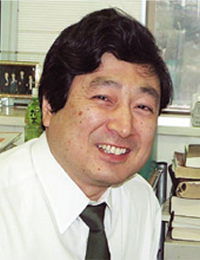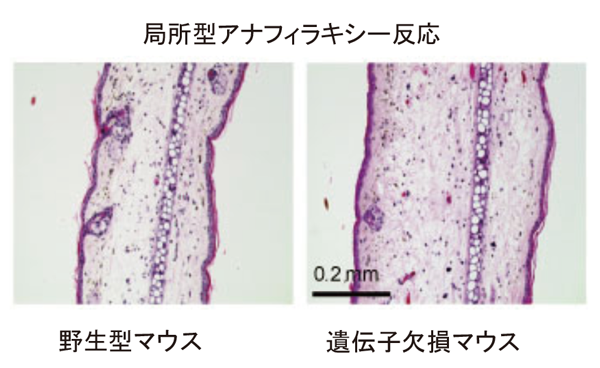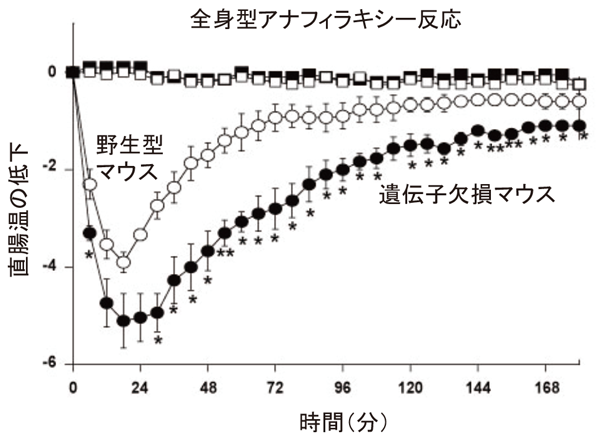キーワード: 難治性免疫疾患、アレルギー、遺伝学、免疫学、臨床免疫学
 免疫は、私たちヒトの身体を感染症などから守る生体防御の仕組みです。しかし、免疫システムの異常が逆に疾患を引き起こしてしまうこともあるのです。リサーチユニット「難治性免疫疾患・アレルギー発症の分子機構解析と分子標的治療開発」は、本学の基礎免疫生物学、遺伝免疫学、臨床免疫学の研究者が結集し互いに共同研究を展開して、これらの難治疾患を克服することを目指しています。
免疫は、私たちヒトの身体を感染症などから守る生体防御の仕組みです。しかし、免疫システムの異常が逆に疾患を引き起こしてしまうこともあるのです。リサーチユニット「難治性免疫疾患・アレルギー発症の分子機構解析と分子標的治療開発」は、本学の基礎免疫生物学、遺伝免疫学、臨床免疫学の研究者が結集し互いに共同研究を展開して、これらの難治疾患を克服することを目指しています。
免疫システムのほころびが疾患を引き起こす
免疫システムは、自己 (self) が非自己(foreign)を認識して排除することにより成り立っています。T 細胞やB 細胞などの多種多様な免疫細胞が、あたかもオーケストラのようにそれぞれの役割を担い、病原微生物などの非自己を排除するのです。
しかし、この精緻なシステムにほころびが生じることがあります。免疫反応が過剰になったり、自己の組織を攻撃したりすることにより、アレルギーや自己免疫病など様々な疾患が引き起こされます。実際、130 ほどのいわゆる難病と呼ばれる疾患(厚生労働省の難治性疾患克服研究事業対象疾患)の半数近くに免疫システムの異常が関わっているのです。
アレルギー発症を抑制する受容体分子
私たちは、免疫システムのほころびが関わる様々な疾患について、その発病機構の解明と克服を目指し研究に取り組んでいます。その一つの研究成果として、アレルギーの発症を抑制する受容体分子を発見しました。
すべてのアレルギーは、花粉やダニなどのアレルゲンが体内でIgE と呼ばれる抗体と結合することから始まります。アレルゲンと結合したIgE が全身に分布する肥満細胞上のIgE 受容体に結合し、活性化した肥満細胞がヒスタミンなどを含んだ顆粒を放出することでアレルギー反応を抑える働きのあることがわかりました(図1)。私たちは、肥満細胞上に発現して肥満細胞からの顆粒の放出を抑制する新しい受容体を発見し、Allergin-1(アラジン-1)と命名しました。アラジン-1 は、肥満細胞からの顆粒放出を抑制し、アレルギー反応を抑える働きのあることがわかりました。もしアラジン-1 の働きを強める薬剤を開発すれば、すべてのアレルギー反応を根本から抑えられる可能性があります。
このように、私たちはこれからも基礎研究と臨床医学の両面から、難治性免疫疾患研究に取り組んでいきます。


図1:アラジン-1 によるアレルギー反応の抑制 Allergin-1 遺伝子欠損マウスは野生型マウ スに比較し、重篤なアナフィラキシー反応を 示した。(局所型:耳の膨張、全身型:体温低下)
社会への貢献・実績
● 難治性免疫疾患およびアレルギー疾患の発症機序の解明
● 発症機序に基づく根治的な治療戦略の開発
● 患者のQOL および生命予後の著明な改善、医療費の削減
取材:平成26年8月5日
Overcome diseases by revealing the basic principles of immunity
Unit name: Molecular Mechanisms and Regulation in Autoimmune Diseases and Allergies
Key words: intractable immune diseases, allergies, genetics, immunology, clinical immunology
 Immunity is a biological defense mechanism to protect human bodies against infections. However, abnormalities of the immune system may cause diseases. Our research unit “Molecular Mechanisms and Regulation in Autoimmune Diseases and Allergies” aims to overcome such intractable diseases through joint research in the fields of basic immunobiology, and genetic and clinical immunology.
Immunity is a biological defense mechanism to protect human bodies against infections. However, abnormalities of the immune system may cause diseases. Our research unit “Molecular Mechanisms and Regulation in Autoimmune Diseases and Allergies” aims to overcome such intractable diseases through joint research in the fields of basic immunobiology, and genetic and clinical immunology.
Abnormalities of the immune system cause diseases.
The immune system is a series of processes of recognition and elimination of “non-self” (foreign) by “self.” Various immune cells, such as T and B cells, play their role in an orchestrated manner to eliminate non-selves such as pathogenic microorganisms.
However, this sophisticated system occasionally fails. Excessive immune reactions and self-tissue attack causes various diseases such as allergies and autoimmune diseases. Nearly half of about 130 intractable diseases (target diseases of the research project to overcome intractable diseases, established by the Ministry of Health, Labour and Welfare) are associated with abnormalities of the immune system.
Receptor molecules to suppress the development of allergies
We are engaged in research aimed at elucidating and overcoming the pathogenic mechanisms of various diseases associated with abnormalities of the immune system. As a result, we discovered a receptor molecule that suppressed the development of allergies.
All allergic reactions initiate through the binding of allergens, such as pollen and mites, to IgE antibodies in the body. IgE antibodies bound to allergens bind to IgE receptors on mast cells distributed throughout the body, and activated mast cells release granules containing histamine to suppress allergic reactions (Figure 1). We discovered a new receptor (Allergin-1) that is expressed on the mast cells and inhibits the release of granules from mast cells. Aladdin-1 was found to inhibit the release of granules from mast cells and suppress allergic reactions. A drug to enhance the functions of Aladdin-1 may substantially suppress all allergic reactions.
In the future, we will continue both basic and clinical research on intractable immune diseases.


Figure 1: Allergic reaction suppression by Aladdin -1
Social contributions and achievements
– Elucidation of the pathogenesis of intractable immune and allergic diseases
– Development of curative treatment strategies based on the pathogenesis
– Significant improvement of patients’ QOL and life prognosis, and reduction of medical expenses
Interviewed on August 5, 2014
